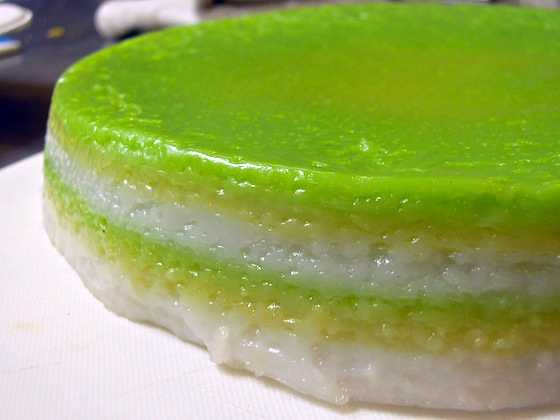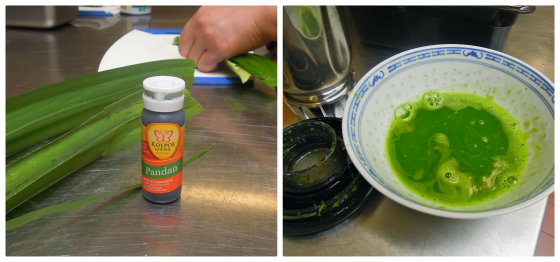
Pandan leaves, extract and after chopping, blending and straining
But first, an explanation of the benefits of steaming from Tran, who admits to being “wonky about food. I like how the science explains what’s happening in the kitchen.” This healthful way of cooking, she tells the eight of us, offers moist heat at a controllable 212 degrees that results in subtle flavors and textures. Traditionally, most people in Asia do not have ovens, and steaming their cakes and other sweets also conserves fuel.
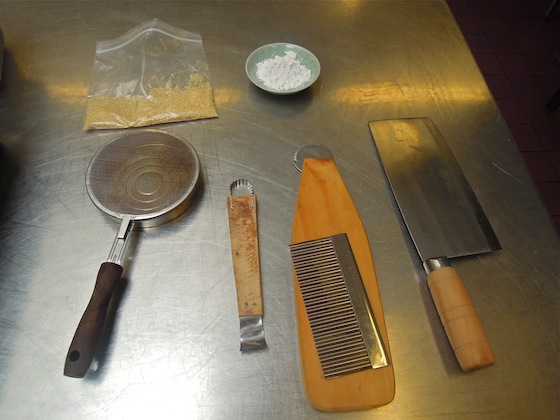
After introducing us to a range of bamboo and metal steaming pans, Tran describes the ingredients we will be using today, including the pandan leaves, a Southeast Asian staple that has the option of a convenient bottled extract. Then, it’s on to tools and techniques. To easily split coconuts, Tran demonstrates how to turn a coconut with one hand, as you give it a series of smart thwacks along its “equator” with the back of a kitchen cleaver, until the sound changes, signaling an imminent split. Then one sits on a special coconut stool with a zig-zaggedy sharp tool held between the knees to scrape out the white flesh.
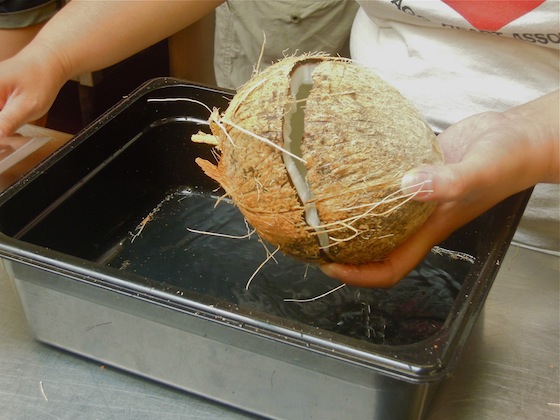
With that, we are on our own, in two teams, to make the three recipes on the sheets provided. Tran keeps a close eye on us, clarifying, adding information, or helping a stuck student (like me with my stubborn pandan cake). The enticing aroma of fresh coconut rides the steamy hot air above the range top, set with our steaming covered pans and pots. Magically, we see our teacups of batter sprout into puffy little cake mushrooms after their steam bath.
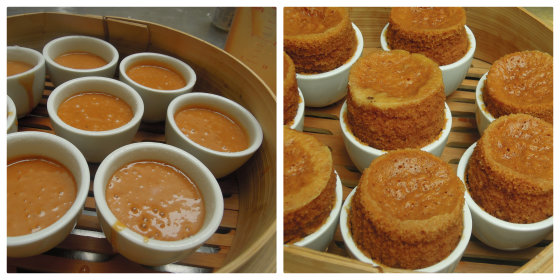
Chinese burnt sugar teacup cakes before and after their steam bath
After enjoying the cakes and sticky rice with mango, I interview Tran about her cooking philosophy and upcoming classes, including a three class Sunday series in July at San Francisco’s 18 Reasons, entitled Fundamental Techniques of Asian Cooking: Fish, Chicken and Eggs.
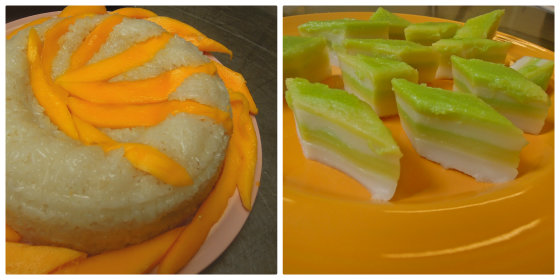
Coconut sticky rice with mango and layered pandan rice cake
I noticed that your classes tend to focus on teaching techniques, rather than a single dish or menu. Why is that?
My goal in focusing on techniques is to wean people away from a dependence on the literal words in a cookbook and empower them to trust what’s in front of them, and rely on their senses. If you are just learning how to cook a specific recipe and don't understand the techniques involved, that won’t necessarily build confidence. The way to dissipate fear is through practice, so students learn to view cooking as a cause and effect process: if I do this, then I can expect that to happen. It’s also true that the move away from prepared foods to whole, organic ingredients adds unpredictability. Non-engineered tomatoes come in a range of sizes, textures and flavors.
In my private classes I often teach a meal-based menu, but I love teaching a series because students can build on their skills. The three classes at 18 Reasons spotlight fundamental techniques in Asian cuisines, organized around three common ingredients, fish, chicken and eggs. It’s empowering to teach students a technique that they can use for a lifetime, even in non-Asian cooking. I think to myself, if I were stuck on an island, which would I rather have: a Thai cookbook or the knowledge of how to gut a fish and combine it with heat and salt?
How do your two current teaching venues compare?
I love working at both OACC and 18 Reasons because they are both consciously working at building community in different ways.
OACC attracts mostly young Asian Americans, often from as far away as San Jose or even Santa Cruz. It's very community based and offers quite reasonably priced classes. The students are predominately young Asian Americans who are learning how to cook the foods they might have grown up with but never learned to prepare themselves. The younger generation is interested in all kinds of Asian foods, so I try to incorporate a variety of flavor profiles into each class.
18 Reasons has a more general approach regarding engaging our community through food and art. They also just moved and have a great new kitchen. They are really open to a wide range of issues and embrace fully the complexity of food. My classes there attract typical San Francisco foodies and that also happens to be a really diverse group.
What prompted your move to the Bay Area?
I grew up in the Midwest and after kind of burning-out working in community-based non-profits, I decided to take my life in a new direction. I came to the Bay Area in 1995 to attend cooking school. But I’ve always been comfortable in the kitchen. As the oldest child, I was my mother’s prep cook since I was 5 years old. The kitchen was where she told me her stories of growing up in Vietnam. Since she worked nights, I started making dinners at age 8. And my birthday gifts always were connected to food. I remember the thrill of getting a Peugeot pepper grinder for my 16th birthday! After culinary school, I worked in restaurants, but found it very isolating. I would put this plate of food up in the window and it would be taken away and I would never know who ate it. Since I think food is such an important way to build connections and since I want to instill confidence and courage, I decided that teaching was a better place for me.
Are you planning any future projects at the Oakland Asian Cultural Center?
We’re talking about a series of classes with an intergenerational focus, to facilitate a sense of learning about food and cooking within the family. We’re trying to create a space where parents and kids can learn together, where parents can relax and not feel pressure to be the expert on traditional dishes, because, quite honestly, they might not know how to make the dishes. Instead, they can experience how easy it is to include kids in their cooking time. It’s just so convenient to go out and have someone else make your wontons or mochi or spring rolls. Important skills and stories are being lost, though, so we’d like to encourage families to begin incorporating a little of that cooking-together time back into their lives in a fun and nonjudgmental way.
You are also the founder and director of the Asian Culinary Forum. How does that relate to your teaching?

